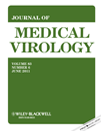The early phase of an HIV epidemic in a population exposed previously to HCV in the Philippines
Abstract
Human immunodeficiency virus (HIV) sentinel surveillance program for injecting drug users has been conducted in Metro Cebu, the Philippines. A low prevalence (0–0.52%) of anti-HIV-positivity had been detected in this population from 2002 to 2007. However, a 10-fold increase in HIV prevalence was detected in the 2009 national HIV sentinel surveillance program. It prompted an additional outreach program to be conducted in Metro Cebu in January 2010, which recorded the highest HIV prevalence rate ever documented in the Philippines (75%, 44/59). HIV genes from fourteen 2009 to 2010 Metro Cebu strains were clustered closely in the phylogenetic tree, but no other strain collected outside Metro Cebu and none stored in the International Nucleotide Sequence Database was allocated to the same phylogenetic cluster. All these HIV infections have emerged in the anti-hepatitis C virus (HCV)-positive population (100%, 62/62) in Metro Cebu from 2009 to 2010. The five HCV strains from the individuals harboring the closely related HIV strains were categorized into different subtypes. These results strongly suggest that HIV infections occurred recently and spread rapidly among injecting drug users, while HCV had been circulating previously among them. Considering the fact that injecting drug use was the first mode of HIV transmission in Asia, extensive monitoring of injecting drug users and associated bridging populations is necessary. Therefore, HCV-guided characterization of the spread of HIV to populations that are vulnerable to blood-borne infections could play an important role in alerting health authorities to the early phase of an HIV epidemic. J. Med. Virol. 83:941–947, 2011. © 2011 Wiley-Liss, Inc.




